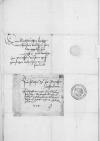Letter #5409
Ioannes DANTISCUS to Albrecht I von Hohenzollern-AnsbachLöbau (Lubawa), 1534-10-09
Manuscript sources:
Auxiliary sources:
Prints:
| ||||||||||||
Text & apparatus & commentary Plain text Text & commentary Text & apparatus
 GStA, PK, HBA, C 2, No 79, f. 5v
GStA, PK, HBA, C 2, No 79, f. 5v
Dem durchlauchten, hochgebornen fursten und hern, / hern
 GStA, PK, HBA, C 2, No 79, f. 1r
GStA, PK, HBA, C 2, No 79, f. 1r
Durchlauchter, hochgeborner furst, grosgunstiger, liber her unnd freundt. Unsere freuntliche, willige dinst zuvoran. /
Wir wissen E(wr) Ir(barkei)t nicht zwbergen, / das wir von unserm underthan, / meister
Dat(um) uff unserm slosse

